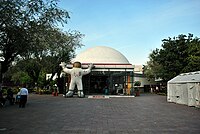
The Tlatelolco massacre was a military massacre committed against the students of the National Autonomous University of Mexico (UNAM), the National Polytechnic Institute (IPN), and other universities in Mexico.

Ciudad Victoria is the seat of the Municipality of Victoria, and the capital of the Mexican state of Tamaulipas. It is located in the northeast of Mexico at the foot of the Sierra Madre Oriental. It borders the municipality of Güémez to the north, Llera to the south, Casas Municipality to the east, and the municipality of Jaumave to the west. The city is located 246 km (153 mi) from Monterrey and 319 km (198 mi) from the US - Mexico border. Ciudad Victoria is named after the first president of Mexico, Guadalupe Victoria.
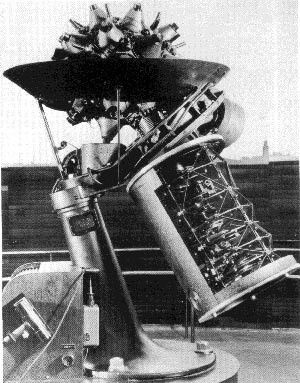
A Zeiss projector is one of a line of planetarium projectors manufactured by the Carl Zeiss Company. Main models include Copernican (1924), Model I (1925), Model II (1926), Model III (1957), Model IV (1957), Model V (1965), Model VI (1968), Spacemaster (1970), Cosmorana (1984), Skymaster ZKP2 (1977), and Skymaster ZKP3 (1993).

Luis Enrique Erro Soler was a Mexican astronomer, politician, and educational reformer.

Politécnico metro station is a Mexico City Metro station in Gustavo A. Madero, Mexico City. It is an at-grade station with two side platforms that serves as the northern terminus of Line 5. It is followed by Instituto del Petróleo station. Politécnico station serves the colonias (neighborhoods) of Industrial Vallejo and Nueva Industrial Vallejo. The station's pictogram features the logo of the National Polytechnic Institute (IPN), a public university in Mexico City, and its name is on account of its proximity to the main campus.
Luis Enrique is a Spanish football manager and former player.

Alfa Planetarium was a planetarium located in Monterrey, Nuevo León, Mexico. This institution was created by ALFA (Mexico) in 1978 to promote science and technology in Latin America. It included an interactive science museum, an Omnimax system cinema, an aviary and an area for temporary exhibits and events. The Alfa Planetarium was one of the most visited cultural centers in Mexico. While its main focus was on science, it also had some art pieces.

Renán Arcadio Poveda Ricalde was a Mexican prominent astronomer who developed a method to calculate the mass of elliptical galaxies. He received Mexico's National Prize for Arts and Sciences in 1975, chaired its National Astronomical Observatory from 1968 to 1980 and was elected to The National College in 1989.

The Galileo Galilei planetarium, commonly known as Planetario, is located in Parque Tres de Febrero in the Palermo district of Buenos Aires, Argentina.
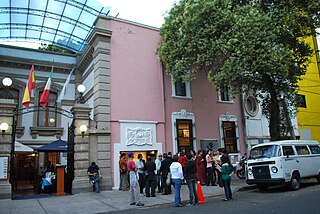
Salón de la Plástica Mexicana is an institution dedicated to the promotion of Mexican contemporary art. It was established in 1949 to expand the Mexican art market. Its first location was in historic center of the city but today it mostly operates out of a building in Colonia Roma. The institution is run by a membership of almost four hundred recognized artists and holds multiple exhibitions each year. Although it operates autonomously, it is part of the Instituto Nacional de Bellas Artes y Literatura.
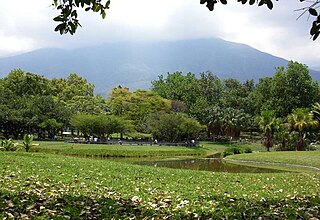
El Parque del Este, renamed as officially Generalissimo Francisco de Miranda Park by Chávez since, in honor of the Venezuelan national hero, is a public recreation park located in the Sucre Municipality of Metropolitan Caracas in Venezuela. Opened in 1961, it is one of the most important of the city, with an area of 82 hectares. The park was designed by Roberto Burle Marx and associates Fernando Tabora and John Stoddart.
The National Polytechnic Institute, abbreviated IPN, is one of the largest public universities in Mexico with 171,581 students at the high school, undergraduate and postgraduate levels. It is the second-best university in Mexico in the technical and engineering domain according to the QS World University Rankings by Subject 2018. It was founded on 1 January 1936 during the administration of President Lázaro Cárdenas.

Tonantzintla Observatory is an astronomical observatory located in the municipality of San Andrés Cholula in the Mexican state of Puebla. It consists of two adjacent facilities: the National Astrophysical Observatory of Tonantzintla, operated by the National Institute of Astrophysics, Optics and Electronics (INAOE), and the National Astronomical Observatory - Tonantzintla, operated by the National Autonomous University of Mexico (UNAM). OANTON is located on the INAOE campus, which includes numerous other buildings. OAN - Tonantzintla is located immediately to the east on mostly unused property. The observatory is located 11 kilometres (6.8 mi) west of Puebla and 33 kilometres (21 mi) east of Popocatépetl, eruptions of which sometimes interfere with observing.

The Museo Universitario del Chopo is located at Doctor Enrique González Martínez Street in the Colonia Santa María la Ribera of Mexico City. It has collections in contemporary art, and is part of the National Autonomous University of Mexico (UNAM).

The Jesús Emilio Ramírez González Planetarium of Medellín is a planetarium located in Medellín, Colombia and established on October 10, 1984. It was originally conceived by the Astronomical Society of the College of San José, led at that time by Brother Daniel, a renowned scientist, astronomer, and botanist. The purpose is that the planetarium is a space for the promotion of scientific and technological culture of citizens and mentality that encourages scientific and technological creativity. The museum is surrounded by a public space known as the Park of Wishes, which was designed by Felipe Uribe de Bedout to coordinate with the planetarium.

The Professor Aristóteles Orsini Planetarium, also known as the Ibirapuera Planetarium, is a planetarium in Ibirapuera Park, São Paulo. It opened in January 1957, and was the first planetarium in Brazil and Latin America. It is one of three planetaria in São Paulo, with the others being Carmo Planetarium and the Johannes Kepler Planetarium at Sabina Escola Parque do Conhecimento.
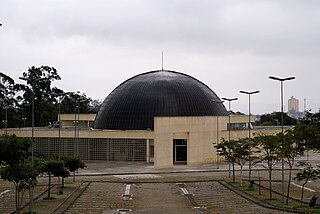
Carmo Planetarium is a planetarium in Parque do Carmo, eastern São Paulo, Brazil. It is part of the Open University of the Environment and Culture of Peace (UMAPAZ), and opened on 30 November 2005. It is one of three planetaria in São Paulo, the others being Professor Aristóteles Orsini Planetarium and the Johannes Kepler Planetarium at Sabina Escola Parque do Conhecimento.

The Madrid Planetarium is a facility in Madrid, Spain, which was inaugurated in 1986. The equipment was updated in 2016/2017.
